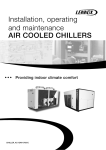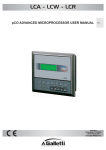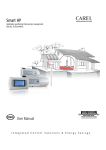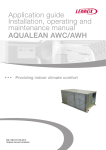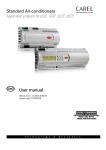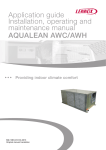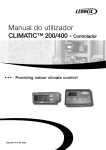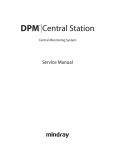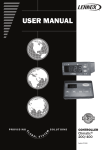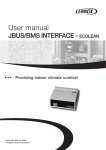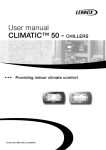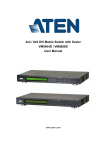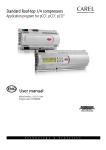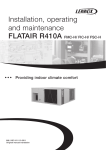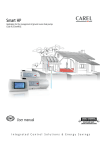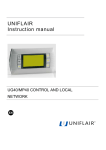Download User manual
Transcript
User manual INNOV@ PCO MICROPROCESSOR Providing indoor climate comfort INNOV@-PCO-IOM-0907-E Index 1 2 GENERAL DESCRIPTION OF THE APPLICATION ................................................... 3 1.1 Program main functions............................................................................................................... 3 1.2 LCD user interface ...................................................................................................................... 3 1.3 LAN network connections............................................................................................................ 3 REGULATION LOGIC ................................................................................................. 4 2.1 Temperature control .................................................................................................................... 4 2.1.1 Close control units with direct expansion coil ........................................................................... 4 2.1.2 Other temperature functions.................................................................................................... 5 2.1.3 Close control units with two water coils.................................................................................... 5 2.1.4 Close control units with single water coil.................................................................................. 6 2.2 Humidity control .......................................................................................................................... 6 2.2.1 Close control units with direct expansion coil........................................................................... 7 2.2.2 Other humidity functions.......................................................................................................... 7 2.2.3 Close control units with water coils .......................................................................................... 8 2.3 Recovery coil .............................................................................................................................. 8 2.3.1 Recovery without cooling devices............................................................................................ 9 2.3.2 Recovery with cooling devices on close contr. units with direct expan. coil............................... 9 2.3.3 Recovery with cooling devices on close control units with water coils .....................................10 2.4 Outlet limit..................................................................................................................................11 2.5 Condenser fans..........................................................................................................................12 2.5.1 Single or separate coils..........................................................................................................12 2.5.2 Condensing pressure probes .................................................................................................12 2.5.3 Prevent function.....................................................................................................................13 2.5.4 Speed-up function..................................................................................................................13 2.5.5 Pressure – temperature conversion........................................................................................13 2.6 Temperature set point compensation..........................................................................................13 2.7 Compressors..............................................................................................................................14 2.7.1 Rotation .................................................................................................................................14 2.7.2 Timing....................................................................................................................................14 2.7.3 Compressor alarms................................................................................................................14 2.8 Heaters ......................................................................................................................................15 2.8.1 Heater alarms ........................................................................................................................15 2.9 Modulating valves ......................................................................................................................15 2.9.1 Three-position valves .............................................................................................................15 2.9.2 0-10Volt VALVES...................................................................................................................16 2.10 3 Outlet fan ...................................................................................................................................16 THE USER INTERFACE ........................................................................................... 17 3.1 Keyboard description..................................................................................................................17 3.1.1 Switch ON/OFF of the unit......................................................................................................17 3.1.2 Screen loop............................................................................................................................17 3.2 Remote user interface ................................................................................................................18 3.2.1 Without local display ..............................................................................................................18 3.2.2 With local display ...................................................................................................................18 4 BOARD CONFIGURATION AND CONNECTION ..................................................... 19 4.1 Address configuration.................................................................................................................19 INNOV@-PCO-IOM-0907-E 1 4.1.1 Address configuration of the microprocessor (pCO1).......................................................................... 19 4.1.2 Address configuration of the PGD ..........................................................................................19 4.1.3 Address configuration of the E2V electronic expansion valve’s driver (EVD) ...........................19 4.2 Boards connection .....................................................................................................................20 4.2.1 Stand alone unit.....................................................................................................................20 4.2.2 Units connected in LAN (max. 8 units)....................................................................................20 4.2.3 LAN status .............................................................................................................................21 4.3 Software update .........................................................................................................................21 4.3.1 Program download from hardware key ...................................................................................21 4.3.2 Program download from computer..........................................................................................22 4.3.3 Restore the default parameters ..............................................................................................22 4.3.4 Language selection................................................................................................................23 5 6 ALARMS.................................................................................................................... 23 5.1 Table of alarms ..........................................................................................................................23 5.2 Alarm data logging .....................................................................................................................24 5.3 Main log .....................................................................................................................................24 SCREENS ................................................................................................................. 26 6.1 List of the screens ......................................................................................................................26 7 LIST OF PARAMETERS AND DEFAULT VALUES................................................... 28 8 ARCHITECTURE OF THE CONTROL SYSTEM ...................................................... 34 8.1 Microprocessor layout ................................................................................................................34 8.2 Configuration list ........................................................................................................................35 8.3 Accessories ...............................................................................................................................35 8.3.1 Electronic expansion valve.....................................................................................................35 8.3.2 Accessories ...........................................................................................................................36 8.3.3 Built-in humidifier ...................................................................................................................37 9 SUPERVISION .......................................................................................................... 37 9.1 Supervisor and bms ...................................................................................................................37 9.2 Gsm protocol..............................................................................................................................39 9.3 Examples of installation..............................................................................................................40 9.4 Shared external display..............................................................................................................40 9.5 Automatic start and stand-by units..............................................................................................41 9.5.1 Critical situations....................................................................................................................41 9.5.2 Forcing ..................................................................................................................................41 9.5.3 Fixed-hour rotation.................................................................................................................42 9.5.4 Fixed-day rotation ..................................................................................................................42 9.5.5 Rotation based on working hours ...........................................................................................42 2 9.6 Master control ............................................................................................................................42 9.7 Technical data............................................................................................................................43 INNOV@-PCO-IOM-0907-E 1 GENERAL DESCRIPTION OF THE APPLICATION This program manages “DX” direct expansion or “CW” water coil air-conditioning units and the main features of the application program are described below. 1.1 Program main functions The program main functions are: • control of temperature and humidity inside civil or technological environments • management of 1 to 2 hermetic compressors • management of 1 to 2 heaters (binary logic available) • 0-10Volt and three-position modulating heating valves • 0-10Volt and three-position modulating cooling valves • built-in humidifier with immersed electrodes • on-off or modulated condensing fans, pressure-controlled • outlet temperature control • alarms management, alarm data logging, devices timing, warnings • complete management of devices timing • connection with local and BMS supervisory networks (Carel, Modbus, LonWorks, …) 1.2 LCD user interface The LCD user interface displays the following data: • measurement of connected probes and calibration, if required • unit start and stop • alarms detection • programming of configuration and operative parameters with access protected by password • controlled devices working hours and time bands with access protected by password • programming of clock and time bands with access protected by password • language selection among the available options (English, Italian, German, French) 1.3 LAN network connections The connection with LAN network allows the program to manage the following functions as well: • automatic time or event rotation among up to 8 units • control of temperature and humidity of max. 8 units, taking the probes of unit no. 1 as a reference • use of only one LCD display for controlling up to 8 units INNOV@-PCO-IOM-0907-E 3 2 REGULATION LOGIC 2.1 Temperature control The heating and cooling devices are managed based on the temperature value measured by the ambient (or room temperature) probe. The measured temperature is compared to the set temperature (set point); the devices are enabled based on the difference between the two values. The proportional band identifies the air-conditioning unit working range and can take different values in heating and cooling mode. The dead zone identifies the devices non-action zone round the set point. The following diagrams show the action of the heating and cooling devices. The percentage values indicate the modulating valves opening range. The warm and cold valves start and end opening parameters correspond to 0% and 100% respectively (default values) and are different for the two valves; if need be, the values may be modified to delay opening start and bring complete opening forward. 2.1.1 Close control units with direct expansion coil Temperature set HEATING COOLING 100% 0% 19.5 22.5 0% 23.0 100% 23.5 3°C 0.5°C 0.5°C Warm proportional band Dead z. Dead z. 26.5 3°C Ambient temp. (°C) Cold proportional band 1 HEATER 1 COMPRESSOR 19.5 22.5 23.0 23.5 26.5 Ambient temp. (°C) COMP.2/ HEATER 1 19.5 HEATER 2 21.5 22.5 COMP.1 23.0 23.5 C1 capacity control 25.0 26.5 Ambient temp. (°C) BINARY MANAGEMENT HEATER 3 19.5 HEATER 2 20.5 HEATER 1 21.5 22.5 COMP.1 23.0 23.5 24.2 C1 c.c. COMP.2 25.0 C2 c.c. 25.7 26.5 Ambient temp. (°C) 0-10 Volt WARM WATER VALVE 100% 0% 19.5 22.5 Ambient temp. (°C) 23.0 Opening start point (0%) Opening end point (100%) 100% 0% 19.5 22.5 23.0 Ambient temp. (°C) Three-position valve running time 4 INNOV@-PCO-IOM-0907-E 2.1.2 Other temperature functions The high and low temperature alarms cause alarm screen signalling and have modifiable delay time. The dehumidification stop differential establishes the minimum temperature below which dehumidification is interrupted. Dehumidification can start again if temperature returns above the value established by the humidification start offset; differential and offset are modifiable. ON OFF Temperature set Dehumidification stop HEAT. 13.0 18.0 20.0 COOL. 22.0 23.0 26.0 3°C Ambient temp. (°C) 33.0 3°C Warm band 4°C Dehumid. start offset 5°C Dehumid. stop different. Cold band 10°C 10°C Low temperature alarm High temperature alarm 2.1.3 Close control units with two water coils These close control units are equipped with a warm water coil and a cold water coil. In addition, heating can also be executed by heaters. The following diagram shows the cooling devices action, whereas the heating devices action is dealt with in the paragraph describing the direct expansion units. Temperature set HEATING COOLING 100% 0% 19.5 22.5 0% 23.0 100% 23.5 3°C 0.5°C 0.5°C Warm proportional band Dead z. Dead z. 26.5 3°C Ambient temp. (°C) Cold proportional band 0-10 Volt WARM WATER VALVE 100% 0% 23.0 23.5 26.5 Ambient temp. (°C) Opening start point (0%) Opening end point (100%) 100% THREE-POSITION COLD WATER 0% 23.0 23.5 26.5 Ambient temp. (°C) Three-position valve running time INNOV@-PCO-IOM-0907-E 5 2.1.4 Close control units with single water coil In these close control units, the coil provides for both heating and cooling, depending on the type of water circulating inside it. In practice, the unit works as it was equipped with two different coils. The coil operation depends from a Summer / Winter digital contact that “reports” whether the circulating water is warm or cold to the board; if the “type of water” circulating inside the coil complies with the ambient request, the valve is modulated to regulate temperature. In addition, heating can also be executed by heaters or a warm coil. For any information about coil and heaters operation, refer to the previous paragraphs. 2.2 Humidity control The humidification and dehumidification devices are managed based on the humidity value measured by the ambient (or room temperature) probe. The measured humidity is compared to the set humidity (set point); the devices are enabled based on the difference between the two values. The proportional band identifies the air-conditioning unit working range and can take different values in humidification and dehumidification mode. The 0.2% fixed dead zone identifies the devices non-action zone round the set point. Dehumidification enables the available cooling devices and a contact for an external dehumidifier or for reducing the outlet fan speed. Dehumidification can be executed as follows: On-Off contact for an external dehumidifier or for reducing the outlet fan speed compressors enabling (active capacity controls included, if any) 100% enabling of the 0-10Volt or three-position modulating cooling valve The dehumidification On-Off free contact is always managed, whereas the cooling devices depend on unit configuration and User selection. The 0-10Volt modulating output of the dehumidification outlet fan is automatically reduced by 50% (modifiable); with On-Off fan, use the digital contact for reducing speed. The following diagrams show the humidification and dehumidification devices action. The percentage values indicate the modulating valves opening range. 6 INNOV@-PCO-IOM-0907-E 2.2.1 Close control units with direct expansion coil Humidity set HUMIDIFICATION 100% DEHUMIDIFICATION 0% 48.0 100% 50.0 Ambient humidity (%) 52.0 2.0% 2.0% Humidification proportional band Dehumidification proportional band 1 COMPRESSOR ON-OFF CONTACT 48.0 + Capacity control, if any 50.0 52.0 Ambient humidity (%) 0-10Volt MODULAT. OUTPUT 100% COMP. 1 + 0% 48.0 COMP. 2 + c.c., if any 50.0 c.c., if any 51.0 52.0 Ambient humidity (%) 100% INTEGRATED HUMIDIFIER 30% 48.0 49.8 Ambient humidity (%) 50.0 2.2.2 Other humidity functions Humidity set 100% 48.0 100% 50.0 2.0% Humidification proportional band Ambient humidity (%) 52.0 2.0% Dehumidification proportional band 100% 0-10V COLD WATER VALVE 0% 50.0 52.0 Ambient humidity (%) 100% THREE-P. COLD WATER VALVE 0% 50.0 52.0 Ambient humidity (%) The high and low humidity alarms cause alarm screen signalling and have modifiable delay time. INNOV@-PCO-IOM-0907-E 7 2.2.3 Close control units with water coils In these close control units, the cold water coils provide for dehumidification. For any information about their operation, refer to the previous paragraph. The following diagrams show the dehumidification devices action. The percentage values indicate the modulating valves opening range. Please note that the dehumidification cold water coils are enabled at 100%, not in modulating mode, in case of both threeposition and 0-10Volt valves. Humidity set 40.0 48.0 50.0 2.0% 52.0 60.0 2.0% Humid. band Ambient humidity (%) Dehumid. band 10.0% 10.0% Low humidity alarm High humidity alarm 2.3 Recovery coil Recovery is an optional function: an additional cold coil using water coming from an external source (i.e., evaporation tower) is enabled if the temperature of water running inside it is quite low. This allows saving on the system management costs. The coil is enabled by On-Off contact or 0-10Volt modulating signal. The following diagram shows the recovery coil enabling conditions: environment cooling request and recovery water temperature lower than recovery set – recovery differential. Temperature set COOLING REQUEST 0% 23.0 23.5 Ambient temp.(°C) 26.5 0.5°C Dead z. 3°C Cold prop. band Recovery set RECOVERY ENABLED 10.0 12.0 2°C Recovery temp.(°C) Recovery differential OFF ON OFF Recovery coil state 8 INNOV@-PCO-IOM-0907-E 2.3.1 Recovery without cooling devices As shown in the previous diagram, the recovery coil only is enabled, whereas the conventional cooling devices are not switched on; as it can be noted in the following diagram, the recovery coil takes up the entire cold proportional band. Temperature set HEATING COOLING 100% 0% 19.5 22.5 0% 23.0 100% 23.5 3°C 0.5°C 0.5°C Warm proportional band Dead z. Dead z. 26.5 3°C Ambient temp. (°C) Cold proportional band RECOVERY ON-OFF CONTACT 23.0 23.5 26.5 0-10V RECOVERY VALVE Ambient temp. (°C) 100% 0% 23.0 23.5 26.5 Ambient temp. (°C) 2.3.2 Recovery with cooling devices on close contr. units with direct expan. coil With recovery coil enabled, the conventional cooling devices are switched on only if ambient temperature increases above a certain value; adding the effects of recovery coil and devices together, temperature decreases, but before reaching the set point, the cooling devices are switched off again. In this case, the cooling devices favour Recovery but do not substitute for it. The following diagram shows how the cooling devices steps are offset compared to normal position to ensure energy saving. INNOV@-PCO-IOM-0907-E 9 Temperature set HEAT. COOLING 0% 22.5 0% 23.0 100% 23.5 0.5°C 0.5°C Dead z. Dead z. 26.5 3°C RECOVERY COIL On-Off OFF 23.0 Ambient temp. (°C) Cold proportional band ON 1 COMPRESSOR 0-10Volt 23.5 24.6 24.9 26.5 Ambient temp. (°C) RECOVERY COIL On-Off OFF 23.0 ON COMPR. 1 COMPR. 2/ 0-10Volt 23.5 C1 can control 24.6 24.9 25.6 26.5 Ambient temp. (°C) RECOVERY COIL On-Off OFF 23.0 ON C.1 C.1 0-10Volt 23.5 C.2 C.2 c.c. 24.6 24.9 25.1 c.c. 25.6 26.1 26.5 Ambient temp. (°C) 2.3.3 Recovery with cooling devices on close control units with water coils The following diagram shows how the cold coil steps are offset compared to normal position to ensure energy saving. Temperature set HEAT. COOLING 0% 22.5 0% 23.0 100% 23.5 0.5°C 0.5°C Dead z. Dead z. 26.5 3°C RECOVERY COIL On-Off OFF 23.0 23.5 Ambient temp. (°C) Cold proportional band ON 0-10V MOD. WARM VALVE 0-10Volt 24.6 24.9 26.5 Ambient temp. (°C) RECOVERY COIL On-Off OFF 23.0 23.5 ON THREE-P- WARM VALVE 0-10Volt 24.6 24.9 26.5 Ambient temp. (°C) 10 INNOV@-PCO-IOM-0907-E 2.4 Outlet limit This function prevents too cold air from circulating in the environment, thus safeguarding health of any exposed person. A temperature probe must be positioned on the air-conditioning unit outlet and parameters “Outlet set point” and “Outlet differential” shall be set. Such parameters identify a limiting zone, as shown in the following diagram: Outlet set 100% VARIABLE LIMITATION TOTAL LIMITATION 0% 10.0 15.0 5.0°C Ambient temp. (°C) Outlet differential Temperature set 1 COMPRESSOR 23.0 23.5 26.5 Ambient temp. (°C) COMPRESSOR 1 COMPRESSOR 2/ C1 can control 23.0 23.5 25.0 26.5 Ambient temp. (°C) COMP.1 23.0 23.5 C.1 c.c. 24.2 COMP.2 25.0 C.1 c.c. 25.7 26.5 Ambient temp. (°C) 0-10V COLD WATER VALVE 100% 0% 23.0 23.5 26.5 Ambient temp. (°C) THREE-POINT COLD WATER VALVE 100% 0% 23.0 23.5 26.5 Ambient temp. (°C) As shown in the diagram, if outlet temperature ranges between outlet set point and outlet differential, the cooling devices are limited only partially; the more temperature decreases the more limitation increases. As regards dehumidification limitation, the modulation zone is by-passed since dehumidification always needs the cooling devices maximum capacity. In practice, the devices are switched off only if outlet temperature is lower than differential; the devices are then switched on again if outlet temperature reaches the outlet set point, as shown in the following diagram: Outlet set ON OUTLET LIMITATION TOTAL LIMITATION OFF 10.0 5.0°C Outlet differential INNOV@-PCO-IOM-0907-E LIMITATION OFF 15.0 Outlet temp. (°C) 11 2.5 Condenser fans Condensing pressure control is available on DX type units, in which fans are managed based on condensing coil pressure and compressors state. Fans are enabled by 0-10V modulating or digital outputs. Control is based on the condensation set point and differential, as shown in the following diagram: Condensation set CONDENSATION 14.0 16.0 2.0 bar Condensation differential HP PREVENT 18.0 HP 20.0 2.0 bar Prevent differential 23.5 24.5 1.0 bar HP differential Condensation pressure (bar) ON OFF Compressor state ON OFF Condensing fans state The following diagram shows fans operation with modulating outputs: 100% 13.0 0% 14.0 16.0 2.0 bar Opening start point (100%) Opening end point (0%) Condensation pressure (bar) The maximum and minimum speeds of 0-10V outputs can be set; in case the set minimum speed is higher than 0V, the fan is operated at minimum speed 1.0 bar below the condensation set point before switching off, as indicated in the diagram above. 2.5.1 Single or separate coils In case of single coil, only one output (on-off or modulating) is enabled. In case of units with at least one condensing probe and enabled on-off outputs, two on-off outputs may be enabled in sequence, dividing the differential by two. In case of separated coils, two different outputs (on-off or modulating) are enabled, one per circuit. 2.5.2 Condensing pressure probes Foreword: besides the values read by the probes, fans enabling always considers the compressors state. In case of single probe and separated coils, fans enabling is based on the probe value for both circuits. In case of two probes and single coil, fans enabling is based on the highest probes value. In case of two probes and separated coils, fans enabling is based on the probe value of the relevant circuit. 12 INNOV@-PCO-IOM-0907-E In case no probe is present, fans are enabled simultaneously with the compressors; in case of single coil, fans are enabled when at least one compressor is on; in case of separated coils, each compressor controls the fans of its own circuit. 2.5.3 Prevent function High pressure alarm prevention with compressors stopped. Normally, the condensing fans turn on only if compressors are enabled, but in this case they are forced so as to decrease pressure and try to prevent the high pressure alarm, which would cause unit shutdown. Pressure increase with compressors stopped may be due to radiance on the coil. In case of 0-10V modulating fans, modulation is by-passed. 2.5.4 Speed-up function To overcome inertia at high-power modulating fans peak, they may be started at maximum speed for some seconds, then speed decreases to the required value and modulation starts. 2.5.5 Pressure – temperature conversion Both pressure and temperature probes can be selected. In case of pressure probes, branch I/O screens display the temperature value corresponding to the pressure of each probe, based on the coolant type (to be selected in the Manufacturer branch). 2.6 Temperature set point compensation The temperature set point can be “compensated” automatically for comfort reasons; for example, think about a commercial concern in which people frequently enter and go out: if internal temperature is 10°C lower than the external one, the thermal rush may annoy people and could be prejudicial to their health. The maximum difference between internal and external temperatures should not exceed 6°C in order to obtain optimum comfort. In this case, the compensation function increases the set point by 4°C, consequently increasing the ambient temperature; this function prevents the difference between internal and external temperature from exceeding 6°C. Compensation requires a temperature probe to be installed at the exterior. The function is managed based on the values of compensation set point, differential and offset parameters, as shown in the following diagram: Compensation set 2°C 25.0 Compensation offset 28.0 3°C Compensation proportional band External temp. (°C) 25.0°C 23.0°C Temperature set-point (°C) INNOV@-PCO-IOM-0907-E 13 2.7 Compressors Compressors are managed in ON-OFF mode. Maximum 2 compressors can be present. 2.7.1 Rotation Compressors rotation follows the F.I.F.O. (first in, first out) logic. The first compressor turned on is the first to turn off, the first compressor turned off is the last to turn on. This logic allows comparing the compressors working hours and obtaining the same ageing. The rotation can be disabled. 2.7.2 Timing START MINIMUM TIME It represents the compressors start minimum time (in seconds) after they have been enabled. If a stop request arises, compressors are disabled only after the established time has elapsed. STOP MINIMUM TIME It represents the compressors stop minimum time (in seconds) after they have been disabled. If a start request arises, compressors are enabled only after the established time has elapsed. MINIMUM TIME BETWEEN DIFFERENT COMPRESSORS STARTS It represents the minimum time interval (in seconds) between start of a device and the following one. This interval allows preventing contemporary peaks, which would cause a high energy absorption. MINIMUM TIME BETWEEN COMPRESSOR STARTS It represents the minimum time interval (in seconds) between two starts of the same device. This parameter allows limiting the number of starts per hour. If, for example, the maximum number of starts per hour allowed by the default values is 10, this limit can be respected by setting a 360-second time interval. 2.7.3 Compressor alarms Compressors alarms are distributed in two digital inputs, the alarms mean Thermal alarm / High and Low pressure alarm. HIGH PRESSURE – THERMAL ALARM Immediate alarm originated by external pressure switch or compressor overload; the digital input switches from closed to open and compressor is immediately stopped. To start the compressor again, the user has to rearm the alarm manually by pushing the display Alarm button, provided that the pressure switch or compressor overload have rearmed energising the digital input. After the compressor has turned off, timing is enabled; for this reason, after alarm rearming, the compressor could not immediately turn on again. LOW PRESSURE ALARM Delayed alarm originated by an external pressure switch. When opening, the digital input enables two timers; if, when the timers delay time (programmable by screen) elapses, the contact is open, the compressor turns off and the alarm goes off. On the contrary, if the contact closes before delay time elapses, the alarm does not go off and timers reset. Timers are: running compressor delay time and compressor start delay time. Running delay is always counted, whereas compressor start delay is counted only if the input opens immediately after compressor start and allows for fluid stabilisation. The two timers are counted in sequence. 14 INNOV@-PCO-IOM-0907-E To start the compressor again, the user has to rearm the alarm manually by pushing the display Alarm button, provided that the pressure switch has rearmed energising the digital input. After the compressor has turned off, timing is enabled; for this reason, after alarm rearming, the compressor could not immediately turn on again. GENERIC ALARM Alarm including all compressor safety devices in a single digital input, used on two-compressor small boards. This alarm goes off immediately when opening the digital input and locks the compressor. To start the compressor again, the user has to rearm the alarm manually by pushing the display Alarm button, provided that the digital input has been energised. After the compressor has turned off, timing is enabled; for this reason, after alarm rearming, the compressor could not immediately turn on again. 2.8 Heaters The heaters are managed as simple ON-OFF loads. Normally up to 2 heaters with the same power can be managed, connected to the 2 outputs. “Binary management” allows the use of three heating steps with just two outputs and 2 loads with different power values: The outputs with binary logic behave as follows: 2 DIFFERENT LOADS STEP 1 Heat.1 = On / Heat.2 = Off STEP 2 Heat.1 = Off / Heat.2 = On STEP 3 Heat.1 = On / Heat.2 = On The outputs are activated with a slight delay from one to the other, to avoid simultaneous peaks. 2.8.1 Heater alarms Each heater is provided with a digital input to be connected with a compressor overload or differential for signalling any failure. Immediate alarm originated when the digital input switches from closed to open; the heater is immediately disabled. To enable the heaters again, the user has to rearm the alarm manually by pushing the display Alarm button, provided that the compressor overload or the differential have rearmed energising the digital input. 2.9 Modulating valves 2.9.1 Three-position valves Valves with three electrical contacts (besides supply): shared, opening and closing. Based on the relays enabling time, the valves opening range varies from 0% to 100% taking an opening/closing time defined as “running time” (time taken to open or close completely; it is a valves rating). The relays must never be enabled simultaneously, thus the valve open, close or keep still. The valves opening range is calculated based on the proportion between temperature differential and running time. When ambient temperature corresponds to the set point, the valves keep closed; the more temperature is offset compared to the set point the more the valves are opened, until they open completely when temperature is equal or higher than set point + / - differential. During operation, the valves are frequently subject to partial opening and closing; the program can recognise the valves opening range at any time by adding up and subtracting all partial times executed from board start-up. INNOV@-PCO-IOM-0907-E 15 REALIGNMENT As there is no feedback to define precisely the valves opening range, the program cannot easily manage the three-position valves. A slight difference between the time calculated by the program and the relays enabling time or a mechanical friction preventing the valves from moving freely may originate discrepancy between the valves actual opening range and the range calculated by the program. To obviate this problem, the following precautions are provided for: whenever temperature control requires a valve complete opening or closing, the program increases the opening or closing relay enabling time by 25% to ensure complete opening/closing. whenever the board is started, the valves are completely closed during the running time; only after time has elapsed, the valves start modulating their opening range based on the control request. 2.9.2 0-10Volt VALVES These valves use a 0-10Volt modulating signal coming from the microprocessor to modify their opening range from 0% to 100%. The 0-10Volt electric signal is directly proportional to the temperature proportional band. Unlike the threeposition valves, these valves do not require adjustment since their opening range is directly proportional to the analogue output value. 2.10 Outlet fan With unit enabled, the outlet fan keeps switched on. It can be managed with On–Off or modulating output. The fan is provided with a thermal alarm and an air flow controller alarm, which lock the unit setting it to OFF state; thermal alarm requires manual rearm, whereas air flow controller alarm is rearmed automatically. Description of modulating management: Temperature set HEATING COOLING 100% 0% 19.5 22.5 3°C 0% 23.0 0.5°C 100% 23.5 0.5°C Warm proportional band 26.5 3°C Cold proportional band 100% 100% 50% Min speed (5.0V) Fan speed Max speed (10.0V) 16 INNOV@-PCO-IOM-0907-E 3 THE USER INTERFACE The provided user interface PGD is equipped with a LCD display (4 rows x 20 columns). and with 6 keys. It allows carrying out all program operations. The user interface allows displaying the unit working conditions at any time and modifying the parameters; furthermore, it may also be disconnected from the main board, as its presence is not strictly necessary. 3.1 Keyboard description The PGD user interface has 6 keys and their use is describe in the following table. Keys Description ALARM key Press ALARM key to enter the alarm menu and to reset the alarms. When an alarm is present the button is illuminated. PROGRAM key Press PROGRAM key to enter the main menu where is possible to select the items: MAINTENANCE, PRINTER, INPUT/OUTPUT, CLOCK, SETPOINT, USER, MANUFACTURER ESC key UP key Press ESC key to go out from a menu and come back into the main screen. Press UP key to move into the next screen or to increment the value of a parameter. ENTER key Press ENTER key to move into the next modifiable parameter field and confirm the modification DOWN key Press DOWN key to move into the previous screen or to decrement the value of a parameter. PROGRAM + ESC keys ESC + ENTER keys Press simultaneously PROGRAM and ESC keys to enter directly the MANUFACTURER menu. Press simultaneously for 5 seconds, ESC and ENTER keys to enter into the screen where you can press ENTER to switch ON/OFF the unit 3.1.1 Switch ON/OFF of the unit The unit is switch On/Off by pressing Esc + Enter keys simultaneously for 5 seconds; after, the displayed screen allows executing the required operation by using Enter key. 3.1.2 Screen loop Press PROGRAM key to display the main menu; then, by using the arrow buttons, move the cursor on the selected item and press Enter to access it. INNOV@-PCO-IOM-0907-E 17 3.2 Remote user interface 3.2.1 Without local display Remote display cable: 6 wires, with RJ11 connectors. Microprocessor pCO1 Remote display wall mounted NOTE: the cable is different from the standard telephone cable because in the remote display cable the connectors are reversed. Unit 3.2.2 With local display Local display panel mounted Derivator TCONN (it is necessary only if local and remote displays are simultaneously present) Microprocessor pCO1 Remote display cable: 6 wires, with RJ11 connectors. Remote display wall mounted NOTE: the cable is different from the standard telephone cable because in the remote display cable the connectors are reversed. Unit 18 INNOV@-PCO-IOM-0907-E 4 BOARD CONFIGURATION AND CONNECTION The LAN network identifies a physical connection between the microprocessor, the display and the drivers for the electronic expansion valves. This connection allows exchanging variables from a board to another, according to a logic established by the software, to make them work together in a functional way. The address of the boards must be configure even in stand alone unit. 4.1 Address configuration 4.1.1 Address configuration of the microprocessor (pCO1) For the configuration of the address of the pCO1 follow these steps: - connected the pCO1 with a display PGD wich the address configure to 0. (See Address configuration of the PGD) - switch ON the power supply pressing simultaneously the ALARM and the UP keys. - press UP or DOWN key to set the address. - press ENTER key to save and exit from this procedure. 4.1.2 Address configuration of the PGD For the configuration of the address of the PGD follow these steps: - press UP+ENTER+DOWN for few seconds - press ENTER and then press UP or DOWN key to set the address. - press ENTER key to save and exit from this procedure. NOTES: - If the addresses of the microprocessor or of the PDG are non corrected, the functioning of the unit is not guaranteed, and the PDG can displays nothing. - after the address configuration of the PGD, it can display the notice “NO LINK” for some seconds. 4.1.3 Address configuration of the E2V electronic expansion valve’s driver (EVD) For the configuration of the driver (EVD) is necessary to set the dip-switch (using a binary logic) that are present inside of the driver, under the frontal box.: Address Driver for circuit 1 9 Driver for circuit 2 10 INNOV@-PCO-IOM-0907-E Dip-switch Open the frontal box to configure the dip-switch. 19 4.2 Boards connection The electrical connection among boards is executed using the following two type of cables: Display connection For the connection of the display is necessary to use a cable with 6 wires and RJ11 connectors; the cable is different from the standard telephone cable because in the display cable the connectors are reversed. LAN connection For the LAN connection is necessary to use a cable with 2 wires plus shield, from unit to unit, by using the terminal strip in the electrical panel (see the specific electrical diagram); the data are sent through Rs485 logic; no additional device is required. 4.2.1 Stand alone unit PGD: Address = 25 Display cable LAN cable LAN cable pCO1: Address = 1 Driver 1: Address = 9 Driver 2: Address = 10 4.2.2 Units connected in LAN (max. 8 units) The units can be connected to the other units in LAN (local area network) for a maximum of 8 units. Each unit can be connected (inside of it) to one or two drivers (EVD) for the management of the electronic valves and to one display for user interface. In the following table are listed the addresses of the microprocessor, of the drivers (EVD) and of the display. List of addresses Address of Microproc. pCO1 Address of EVD Driver 1 Address of EVD Driver 2 Address of Display Config. by display Config. by dip-switch Config. by dip-switch Config. by display Unit 1 1 9 10 25 Unit 2 2 11 12 26 Unit 3 3 13 14 27 Unit 4 4 15 16 28 Unit 5 5 17 18 29 20 INNOV@-PCO-IOM-0907-E Unit 6 6 19 20 30 Unit 7 7 21 22 31 Unit 8 8 23 24 32 The address of the microprocessor can be read from the main screen in the lower right corner. The display with address 32 allows controlling all boards without requiring other displays or in addition to the other displays; as a matter of fact, the program allows display with address 32 to access the parameters of all connected boards, one by one. Passage among the boards can be executed by simply pushing button ESC + DOWN. 4.2.3 LAN status When starting the system, the LAN network could undergo some problems (failed boards and displays displays start-up) due to improper electrical connections or to the fact that incorrect addresses have been assigned. By means of a special screen, the LAN network state can be displayed in real time, thus identifying which devices (boards and displays) are properly connected and addressed. To display the special screen, push buttons Up-Down-Enter of any network display simultaneously for at least 10 sec. After the first 5 seconds, a screen is displayed; continue for another 5 seconds until the following screen is displayed: As it can be seen, network addresses from 1 to 32 are displayed, together with a symbol indicating if a display (small rectangle) or a board / valve driver (big rectangle) is concerned. The dash indicates that the board / display has incorrect address or is connected improperly. In case the symbols appear and disappear, it means that LAN is unstable or, more probably, that repeated addresses are present. The number following T indicates the address of the display being used. The example indicates that the network consists of one boards or valves drivers with address 1 and of one display with address 25. After the screen is checked, if there is some trouble cut network power off, verify connections and addresses and power the system again. 4.3 Software update If is necessary a software update the boards shall be programmed by DOWNLOADING the application program to the Flash buffer memory; this operation can be performed either using the hardware key or a computer. 4.3.1 Program download from hardware key To connect the key to the pCO1, proceed as follows: 1. Switch the pCO1 off and remove the “expansion memory” cover using a screwdriver. 2. Place the key selector on INNOV@-PCO-IOM-0907-E . 21 3. Insert the key into the corresponding slot. 4. Press Up and Down together in the display and switch the board on. 5. Check that the red key LED comes on. 6. Wait until the upload request is displayed on the LCD, then release the buttons and confirm by pressing Enter; the data transfer operation will take approximately 10 seconds. 7. Switch the pCO1 off, remove the key, place the cover in its original position and switch the board back on again. 8. The board will now work with the program transferred from the key. 4.3.2 Program download from computer Use the the converter (RS232/RS485) and the WinLOAD 32 program, proceeding as follows: 1. Connect the converter (RS232/RS485) to the mains using the transformer provided in the kit. 2. Connect the converter to a free serial port on the PC, using the serial cable provided in the kit. 3. Connect the converter to connector J10 on the pCO1 using a telephone cable. 4. Install Winload, if Winload is not already installed on the PC. 5. Run WinLOAD32 on the PC, with the board off. 6. Enter in the number of the PC serial port in the field “COMM” (1 for COM1, 2 for COM2). 7. Enter “0” in the field “pCO ADD.”. 8. Switch the board on. 9. Wait 30 seconds until the message “OFF LINE” becomes “ON LINE” in the WinLOAD32 program, in the lower left, or until the yellow LED next to the dipswitch on the board starts flashing; now enter the actual board LAN address value in the field “pCO² ADD”; a blue light in the Winload program, in the bottom centre of the window, will start flashing. 10. In WinLOAD32, select “Upload” and then “Application”. 11. Select the folder containing the application program source files. 12. Use CTRL to select a series of *.iup files, if needing to load a series of languages to the pCO1. Also select the *.blb files (for non-LAN applications) or the flash1.bin file in the program being loaded (for LAN applications). 13. Click “UPLOAD” to start the file download procedure, which will take approximately 1 to 5 minutes, depending on the number of *.iup files selected and the size of the various files. 14. Wait until the message “Upload OK” appears in the progress bar. 15. Disconnect the telephone cable between the board and converter; connect the external display (if featured), then switch the board off and on again. NOTE: if a LAN network with a series of boards is used, the program can be installed on the other boards without repeating the operations: after installing the program on the first board, simply repeat steps from 8 to 14, entering the new board addresses each time in the field “pCO ADD” in the WinLOAD32 program. 4.3.3 Restore the default parameters Default parameters are the values assigned by manufacturer to the application program main operative parameters. Parameters are assigned automatically when executing the DOWNLOAD operation as described above. Parameters indicate timing, set points, differentials, etc… (refer to the complete list of default values). After installing default values, the parameters must be modified following the special parameter list with the specific parameter of the installed unit. Operations to be carried out for default parameters manual installation: 1. Push buttons PRG + ESC keys and type the Manufacturer password, then push Enter. 2. By pushing button Down three times, move the cursor on “INITIALIZATION” (last row), then push ENTER. 3. The parameters installation screen is displayed; to install, push ENTER and type the Manufacturer password. 4. WARNING: we recommend extreme care since this operation deletes all the installed parameters from the memory and replaces them by the default parameters – after this operation, parameters cannot be restored. 5. After pushing ENTER, message “PLEASE WAIT” is displayed for some seconds. 6. Switch off and then switch on the power supply. 22 INNOV@-PCO-IOM-0907-E 4.3.4 Language selection English is the language automatically selected, but it can be changed into: Italian, French, German, Spanish. To modify the language, operate as follows: 1. Press the PROGRAM key, select the MAINTENANCE item and press ENTER 2. Press ENTER in the screen A0, and UP or DOWN to modify the language 3. Press ENTER to confirm the new language. 5 ALARMS The alarms managed by the program safeguard soundness of the connected devices and provide signals in case the control parameters have exceeded the normal values or the board is faulty. The alarms originate from alarm digital inputs, probes or board. Their effect ranges from the simple block signalling of one or more devices to the air-conditioning unit stop. Many alarms are subject to programmable delay times. When an alarm state is identified, the following signals occur: the red LED under button ALARM turns on abbreviation AL starts blinking on the Menu screen Pushing button Alarm, the buzzer switches off and the alarm screen is displayed. If more alarms are active, the screen of the first alarm is displayed; the other alarms can be displayed by using the arrow buttons. If other buttons are pressed, the alarm screens are left but they keep stored and are displayed again whenever the Alarm button is pressed. To rearm the alarms and delete the message manually, simply move the cursor on the alarm screens and push button Alarm again; if the alarm causes have disappeared (digital inputs rearmed, temperature within the normal values, etc…), the screens disappear, the red led switches off and message “NO ALARM ACTIVE” is displayed. If the cause of one or more alarms is still active, the disabled alarms only disappear, whereas the other alarms keep displayed and the buzzer and the red led switch on again. Alarms are divided into two categories: manually-rearmed alarms or automatically-rearmed alarms. The manually-rearmed alarms require alarm screen deleting (as described above) to restart the devices or the air-conditioning unit. The automatically-rearmed alarms unlock the device or restart the air-conditioning unit after the cause has disappeared, but the alarm screen keeps stored in the memory. 5.1 Table of alarms CODE DESCRIPTION DELAY UNIT OFF A01 A02 A03 A04 A05 A06 A07 A08 A09 A10 A11 A12 A13 A14 A15 A16 A17 A18 Compressor 1 general alarm Compressor 2 general alarm Compressor 1 low pressure Compressor 2 low pressure No air flow Outlet fan thermal Heater 1 thermal Heater 2 thermal Fire / Smoke detection Dirty filters High ambient temperature Low ambient temperature High ambient humidity Low ambient humidity Compressor 1 working hours threshold reached Compressor 2 working hours threshold reached Outlet fan working hours threshold reached Ambient temperature probe faulty or disconnected Recovery water temperature probe faulty or disconnected External air temperature probe faulty or disconnected Outlet air temperature probe faulty or disconnected Ambient humidity probe faulty or disconnected Condenser 1 pressure probe faulty or disconnected Condenser 2 pressure probe faulty or disconnected Condenser 1 temperature probe faulty or disconnected Condenser 2 temperature probe faulty or disconnected High humidifier current see T2 see T2 see T4 see T2 see T2 see T2 see T2 60 sec (fixed) yes yes yes - 60 sec (fixed) - - 60 sec (fixed) 60 sec (fixed) 60 sec (fixed) 60 sec (fixed) 60 sec (fixed) 60 sec (fixed) 60 sec (fixed) - - Humidifier A19 A20 A21 A22 A23 A24 A25 A26 A27 INNOV@-PCO-IOM-0907-E DISABLED Compressor Compressor Compressor Compressor All All Heater 1 Heater 2 All - 1 2 1 2 23 A28 A29 A30 A31 A32 A33 A34 A35 A36 A37 A38 A39 A40 A41 A42 A43 A44 A45 A46 A47 A48 A49 A50 A51 A52 A53 A54 A55 A56 A57 A58 A59 A60 No water inside humidifier cylinder No current in humidifier Clock card not present / faulty Circuit 1 high pressure Circuit 2 high pressure Water under floor Auxiliary alarm Compressor 1 high pressure + thermal Humidifier working hours threshold reached Compressor 2 high pressure + thermal Condensing fan 1 thermal Condensing fan 2 thermal No water flow pLAN disconnected Driver 1 alarm, probes faulty or disconnected Driver 1 EEPROM faulty or damaged Driver 1 valve motor faulty or damaged Driver 1 alarm, battery discharged or faulty Driver 1 high evaporation pressure (MOP) Driver 1 low evaporation pressure (LOP) Driver 1 low superheating Driver 1 valve not closed during blackout Driver 1 high suction pressure Driver 2 alarm, probes faulty or disconnected Driver 2 EEPROM faulty or damaged Driver 2 valve motor faulty or damaged Driver 2 alarm, battery discharged or faulty Driver 2 high evaporation pressure (MOP) Driver 2 low evaporation pressure (LOP) Driver 2 low superheating Driver 2 valve not closed during blackout Driver 2 high suction pressure Built-in humidifier: high conductivity alarm A61 Built-in humidifier: high conductivity pre alarm A62 A63 A64 A65 A66 A67 Built-in humidifier: low steam production Built-in humidifier: water drain alarm Built-in humidifier: cylinder full alarm Built-in humidifier: cylinder being depleted signal Built-in humidifier: presence of foam Built-in humidifier: cylinder depleted ? ? see T4 60 sec (fixed) See Fj See Fj See Fi See Fi See Fj See Fj See Fi See Fi See threshold Gb: delay 1h See threshold Gb: delay 1h yes yes - Compressor 1 Compressor 2 All Compressor 1 Compressor 2 Condensing fan 1 Condensing fan 2 All Compressor 1 Compressor 1 Compressor 1 Compressor 1 Compressor 1 Compressor 2 Compressor 2 Compressor 2 Compressor 2 Compressor 2 - - Humidifier - - - Humidifier Humidifier Humidifier - 5.2 Alarm data logging Alarms data logging allows storing the air-conditioning unit working state whenever an alarm goes off or under particular conditions. Any storing operation becomes an event, which can be displayed as any other event available in the memory. As it functions as a device for “taking photographs” of the system whenever any alarm goes off, data logging is extremely useful for suggesting possible causes and solving system malfunctions and failures. The program is provided with a MAIN and a DEVELOPED data logging. 5.3 Main log Events can be stored thanks to the boards very large buffer memory. The MAIN data logging can be enabled by parameter; if the clock card (optional) is not available, neither the MAIN data logging is available. No additional optional card is required. The maximum number of storable events is 100; after the last space available in the memory (alarm no. 100) is used, next alarm will be overwritten on the first alarm stored (001), which will be automatically deleted. This procedure applies to all following events. The user cannot delete the stored events except at the default values installation. The MAIN data logging screen can be accessed by pushing button ALARM when screen E4 is displayed and can be left by pushing button Esc. The screen is displayed as follows: 24 INNOV@-PCO-IOM-0907-E Whenever an alarm goes off, the following air-conditioning unit data are stored for each alarm: alarm description time date event chronological number (0-100) The event chronological number, displayed in the upper right corner, indicates the event “stay time” compared to the 100 available memory spaces. Alarm no. 001 represents the first alarm gone off after MAIN data logging enabling. Moving the cursor on the chronological number and using the arrow buttons, the alarms “history” can be scrolled from 1 to 100. In position 001 and pushing the down arrow, the alarms cannot be scrolled. If, for example, 15 alarms have been stored and the cursor is in position 015, pushing the up arrow, the alarms cannot be scrolled. INNOV@-PCO-IOM-0907-E 25 6 SCREENS The screens are divided into these categories: MAINTENANCE: checking the devices periodically, calibrating the connected probes, modifying the working hours and managing the devices manually. PASSWORD = 105 PRINTER: printing the list of parameter only with a special version of display. NO PASSWORD INPUT/OUTPUT: allow to show the digital and analog input/output values. NO PASSWORD CLOCK: allow setting and enabling the temperature and humidity time bands. PASSWORD = 108 SETPOINT: allow setting the temperature and humidity set points and regulating the clock. NO PASSWORD USER: allow setting the main functions (timing, sets, differentials) of the connected devices; PASSWORD = 108 MANUFACTURER: allow configuring the air-conditioning unit, enabling the main functions and selecting the connected device. PASSWORD = available on request. This menu is divided into these categories: CONFIGURATION, PARAMETERS, CAREL EXV DRIVERS, TIMING AND INITIALIZATION. 6.1 List of the screens The following list indicates the displayed screens. Columns represent the screens loops: the first screen (A0, B0…) can be displayed by pushing the relevant button and the other screens can be scrolled by using the arrow buttons. Codes (Ax, Bx, Cx…) are displayed in the screens upper right corner, so as to be easily identified. The meaning of symbols “0”,”1”… is explained in the previous paragraph. Symbol PSW indicates the screens for entering passwords. MAIN M0 M1 M2 26 MAINTENANCE A0 A1 A2 A3 A4 A5 PSW A6 A7 A8 A9 Aa Ab Ac Ad Ae Af Ag Ah Ai Aj Ak Al Am An PRINTER H0 H1 INPUT/OUTPUT CLOCK SETPOINT USER I0 I1 I2 I3 I4 I5 I6 I7 I8 I9 Ia Ib Ic Id Ie If Ig Ih Ii Ij Ik Il Im In Io Ip Iq Ir Is It Iu Iv K0 PSW K1 K2 K3 K4 K5 K6 K7 K8 K9 Ka S0 S1 PSW P0 P1 P2 P3 P4 P5 P6 P7 P8 P9 Pa Pb Pc Pd Pe Pf Pg Ph Pi Pj INNOV@-PCO-IOM-0907-E MANUFACTURER PSW Z0 Z1 CONFIGURATION C0 C1 C2 C3 C4 C5 C6 C7 C8 C9 Ca Cb Cc Cd Ce Cf Cg Cj Ci Cl Cm Cn Co Cp Co Cp PARAMETERS G0 G1 G2 G3 G4 G5 G6 G7 G8 G9 Ga INNOV@-PCO-IOM-0907-E Gb Gc Gd Ge Gf Gg Gh Gi Gj Gk Gl Gm Gn Go CAREL EXV DRIVER F0 F1 F2 F3 F4 F5 F6 F7 F8 F9 Fa Fb Fc Fd Fe Ff Fg Fh Fi Fj TIMING T0 T1 T2 T3 T4 T5 T6 T7 T8 INITIALISATION V0 V1 V2 27 7 LIST OF PARAMETERS AND DEFAULT VALUES The table below lists the parameters in the program, together with the following information: screen code (the screen code is displayed at the top right) to assist the identification of the parameter, the default value, the minimum and maximum limits (range), and the unit of measure. To find a specific parameter on the display, proceed as follows: Identify the parameter in the table below and the corresponding screen code Using the list of the screens (following paragraph) and the screen code, access the screen on the display PARAMETER DESCRIPTION SCREEN DEFAULT Maintenance Menu Select display language Enter password Modify outlet fan operating hours Modify compressor 1 operating hours Modify compressor 2 operating hours A0 A6 A7 A7 A7 English ---0 0 0 En, It, Fr, De 0-9999 0-99 . 0-999 0-99 . 0-999 0-99 . 0-999 Device operating hour threshold: main fan A8 99 0-99 Device operating hour threshold: compr. circuit 1 A8 99 0-99 Device operating hour threshold: compr. circuit 2 A8 99 0-99 Humidity probe calibration Condenser 1 pressure probe calibration Condenser 2 pressure probe calibration Ambient temperature probe calibration External temperature probe calibration Supply temperature probe calibration Recovery temperature probe calibration Condenser 1 temperature probe calibration Condenser 2 temperature probe calibration Manual activation of digital outputs 1 – 2 – 3 Manual activation of digital outputs 4 – 5 – 6 Manual activation of digital outputs 7 – 8 – 9 Manual activation of digital outputs 10 – 11 – 13 Manual activation of modulating outputs 1 – 2 Manual activation of modulating outputs 3 – 4 Manual activation of pre wash built-in humidifier Manual activation of total water drain built-in humidifier Hum. management: periodic drain enable Hum. management: periodic drain period Hum. management: stop delay Hum. management: drain for inactivity period Hum. management: threshold running hours Driver 1 valve control mode Driver 1 valve manual opening steps Driver 2 valve control mode Driver 2 valve manual opening steps Driver 1 manual release on start-up Driver 2 manual release on start-up Enter new Maintenance password A9 A9 A9 Aa Aa Aa Ab Ab Ab Ac Ad Ae Af Ag Ah Ai 0 0 0 0 0 0 0 0 0 Off Off Off Off 0 0 No -9.9 – 9.9 -99.9 – 99.9 -99.9 – 99.9 -99.9 – 99.9 -99.9 – 99.9 -99.9 – 99.9 -99.9 – 99.9 -99.9 – 99.9 -99.9 – 99.9 Off – On Off – On Off – On Off – On 0-10.0 0-10.0 No-Yes Ai No No-Yes Ai1 Ai1 Ai2 Ai2 Ai3 Aj Aj Ak Ak Al Am An No 120 0 3 4000 Automatic 0 Automatic 0 No No ---- No-Yes 0-120 0-120 1-199 0 - 4000 Auto-Man. 0-9999 Auto-Man. 0-9999 No-Yes No-Yes 0-9999 Cyclical print interval Send immediate print H1 H1 Printer Menu 24 No 0-999 No-Yes hours Hour setting Minute setting Day setting Month setting Year setting Enter Clock password K0 K0 K0 K0 K0 K1 Clock Menu current hour current minutes current day current month current year ---- 0-23 0-59 1-31 1-12 0-99 0-9999 hours minutes 28 SPECIAL VALUE RANGE INNOV@-PCO-IOM-0907-E UOM hours hours hours hours x 1000 hours x 1000 hours x 1000 %RH bar bar °C / °F °C / °F °C / °F °C / °F °C / °F °C / °F Volt Volt hours seconds hours hours Steps Steps PARAMETER DESCRIPTION SCREEN DEFAULT SPECIAL VALUE RANGE UOM K2 No / No / No No-Yes K3 9 / 13 / 14 / 21 0-23 hours K3 0/0/0/0 0-59 minutes K4 K4 14 / 21 0/0 0-23 0-59 hours minutes Enable temperature / humidity / On-Off time bands Start and end hour for On-Off time bands F1-1and F1-2 Start and end minutes for On-Off time bands F1-1 and F1-2 Start and end hour for On-Off time band F2 Start and end minutes for On-Off time band F2 Select On-Off time bands (F1,F2,F3,F4) for each day Start hour temperature bands 1 and 2 Start minutes temperature bands 1 and 2 Set point temperature bands 1 and 2 Start hour temperature bands 3 and 4 Start minutes temperature bands 3 and 4 Set point temperature bands 3 and 4 Start hour humidity bands 1 and 2 Start minutes humidity bands 1 and 2 Set point humidity bands 1 and 2 Start hour humidity bands 3 and 4 Start minutes humidity bands 3 and 4 Set point humidity bands 3 and 4 Enter new Clock password K5 F3 F1-F2-F3-F4 K6 K6 K6 K7 K7 K7 K8 K8 K8 K9 K9 K9 Ka 0/6 0/0 23.0 / 23.0 12 / 18 0/0 23.0 / 23.0 0/6 0/0 50.0 / 50.0 12 / 18 0/0 50.0 / 50.0 ---- 0-23 0-59 see P1 0-23 0-59 see P1 0-23 0-59 see P2 0-23 0-59 see P2 hours minutes ºC / ºF hours minutes ºC / ºF hours minutes %RH hours minutes %RH Temperature set point Humidity set point S1 S1 Setpoint Menu 23.0 50.0 see P1 see P2 ºC / ºF %RH Enter user password Minimum and maximum temperature set point limits Minimum and maximum humidity set point limits Proportional temperature bands (differential) in Heating and cooling Temperature dead zone (neutral zone) Proportional bands in Humidification and Dehumidification Maximum production allowed, built-in humidifier Show language screen at start-up Switch unit off from button Enable remote On-Off digital input Recovery water temperature set point Recovery air temperature set point / Differential Enable compensation function Outside air compensation set point Outside air compensation differential band Offset maximum of compensation of the set of temperature High and low ambient temperature alarms offset respect the setpoint High and low ambient humidity alarms offset respect the setpoint Enable outlet limit function Outlet air set point for the limitation function Outlet air differential for the limitation function Assign type of alarm Serious/Minor AL01-AL20 Assign type of alarm Serious/Minor AL21-AL40 Assign type of alarm Serious/Minor AL41-AL60 Assign type of alarm Serious/Minor AL61-AL70 Board identification number for supervisory network Board communication speed for supervisory network P0 User Menu ---- 0-9999 P1 -99.9 / 99.9 P2 0.0 / 100.0 0.0-100.0 %RH P3 3.0 / 3.0 0.0-100.0 ºC / ºF P3 0,5 0.0-99.9 ºC / ºF P4 2.0 / 2.0 0.0-99.9 %RH P4 P5 P5 P5 P6 P6 P7 P7 P7 70.0 No Yes Yes 12,0 3.0 / 2.0 No 25.0 3.0 0% -100% No-Yes No-Yes No-Yes 0-99.9 0-99.9 No-Yes -999.9-999.9 -999.9-999.9 % kg/h P7 2.0 -999.9-999.9 ºC / ºF P8 10.0 / 10.0 -999.9-999.9 ºC / ºF P9 20.0 / 30.0 0-100,0 %RH Pa Pa Pa Pb Pc Pd Pe No 15.0 5.0 All N All N All N All N No-Yes -999.9-999.9 -999.9-999.9 N-Y N-Y N-Y N-Y Pf 1 0-200 Pf 1200 1200-19200 Serial communication protocol Pf Carel Telephone numbers entered on analogue modem Enter telephone numbers on analogue modem Number of rings for GSM modem Password to write SMS text message Destination GSM telephone number Pg Pg Pg Pg Pg 0 0 0 0 0 INNOV@-PCO-IOM-0907-E -999.9-999.9 ºC / ºF ºC / ºF ºC / ºF ºC / ºF ºC / ºF ºC / ºF ºC / ºF Baudrate Carel, Modbus, Lon, RS232, Gsm 1-4 0…9,#,*,@,ˆ 0-9 0-9999 0…9,#,*,@,ˆ 29 PARAMETER DESCRIPTION SCREEN DEFAULT Number of rings for analogue modem Password for supervisor remote connection Type of analogue modem Enter new user password Ph Ph Ph Pi 0 0 Tone ---- Enter manufacturer password CONFIGURATION --> Enable BMS Enable printer Select unit of measure for temperature probes and parameters Enable clock board Type of unit Z0 Manufacturer Menu ---- SPECIAL VALUE RANGE 0-9 0-9999 Tone-Pulse 0-9999 0-9999 C0 C0 No No No-Yes No-Yes C0 ºC ºC-ºF C0 C1 No ED Select refrigerant C1 R407C Number of compressors Enable compressor capacity-control steps (unloaders) Heating mode Humber of heaters Type of valve for heating battery Type of coil Type of valve for the coil Heating mode Humber of heaters Type of valve for heating coil C2 2 No-Yes ED-CW R22,R134a, R404a, R407C, R410A 1-2 C2 No No-Yes C2 C2 C2 C3 C3 C3 C3 C3 Heaters 2 0-10Volt C/H 0-10Volt Heaters 2 0-10Volt Digital input 5 configuration C4 Filter alarm Digital input 12 configuration C5 Fire/smoke alarm Digital input 1 configuration C6 Fire/smoke alarm Digital output 7 configuration C7 Light alarm relay Analog input 2 configuration C8 Pressure circ. 1 Analog input 3 configuration C9 Pressure circ. 2 Modulating output 1 configuration Ca Main fan damper Recovery type Enable analog humidifier output Ca Ca Air No Analog output 2 configuration Cb Recovery damper Recovery damper enable Main fan damper presence Enable condensation function Type of condenser Condensing output type Select number of condensing fans Maximum voltage threshold for Triac Minimum voltage threshold for Triac Cc Cc Cd Cd Cd Cd Ce Ce No No No Single Inverter 1 92,0 7,0 Heaters-Battery 0-1-2-Binary 0-10V / 3 points C/H-Cool 0-10V/ 3 points Heaters-Battery 2 0-1-2-Binary 0-10V/3 points Flood alarm, Filter alarm, Fire alarm Fire/smoke alarm, Water Flood alarm Fire/smoke alarm, Water Flood alarm Recovery valve, Light alarm relay Pressure circ.1, Temp. circ. 1, Supply air temp. Pressure circ.2, Temp. circ. 2, Recovery temp. Recovery damper, Main fan damper Air, Water No-Yes Recovery damper, Humidif. damper No-Yes No-Yes No-Yes Single-Separat. Inverter-Steps 1-2 0-100 0-100 Duration of Triac impulse Ce 2 0-10 Logic of the dehumidification contact Number of compressors enabled for dehumidification Enable cooling coil for dehumidification Enable built-in humidifier Type of humidifier Maximum production Cf NC NO-NC Cf 0 0-2 Cf Cf Cg Cg No No 3 Kg/h 400V 3Ph 70.0 Humidifier board type Cg PCOUMID000 Enable humidity probe Ch Yes Type of signal from the humidity probe Ch Current No-Yes No-Yes 3 Kg/h / 8 Kg/g 0-100.0 PCOUMID200PCOUMID000 No-Yes 0-1V, 0-10V, Current 30 UOM INNOV@-PCO-IOM-0907-E % % m seconds % PARAMETER DESCRIPTION Minimum and maximum value measured by the humidity probe Enable pressure probe 1 SCREEN DEFAULT Ch Ci SPECIAL VALUE RANGE UOM 0.0 / 100.0 0-100.0 %RH No No-Yes 0-1V, 0-10V, Current -20.0 - 50.0 No-Yes 0-1V, 0-10V, Current -20.0 - 50.0 NTC-PT1000 No-Yes NTC-PT1000 No-Yes NTC-PT1000 No-Yes NTC-PT1000 No-Yes NTC-PT1000 No-Yes NTC-PT1000 Present/Rotation Present/No rotat. Not present Present/Rotation Present/No rotat. Not present Present/Rotation Present/No rotat. Not present Present/Rotation Present/No rotat. Not present No-Yes Off-On Off-On 0-999 No Reheating, Elect. Heaters, Hot gas On/Off, Hot gas modulat. Type of signal pressure probe 1 Ci Current Minimum and maximum value pressure probe 1 Enable pressure probe 2 Ci Cj 0.0 / 30.0 No Type of signal pressure probe 2 Cj Current Minimum and maximum value pressure probe 2 Room temperature probe type Enable supply air probe Supply air temperature probe type Enable external temperature probe External temperature probe type Enable recovery temperature probe Recovery temperature probe type Enable condenser 1 temperature probe Condenser 1 temperature probe type Enable condenser 2 temperature probe Condenser 2 temperature probe type Cj Ck Ck Ck Cl Cl Cl Cl Cm Cm Cm Cm 0.0 / 30.0 NTC Yes NTC No NTC No NTC No NTC No NTC LAN unit configuration Unit 1 (U1) Cn Present/No rotat. LAN unit configuration Unit 2-3 (U2-U3) Cn Not present LAN unit configuration Unit 4-5-6 (U4-U5-U6) Co Not present LAN unit configuration Unit 7-8 (U7-U8) Cp Not present Enable analog fan on analog out 2 Enable expansion card Enable expansion card alarm Expansion card alarm delay Cq Cr Cr Cr Yes Off Off 120 Reheating system Cs No Reheating G0 No No-Yes G1 G1 G1 Yes Prop. NC No-Yes Prop.-P+I NC-NO G2 50.0 0.0-100.0 % G2 0.0 / 100.0 0.0-100.0 % G3 50,0 0.0-100.0 % G3 0.0 / 100.0 0.0-100.0 % G4 0.0 / 100.0 0.0-100.0 % G5 0.0 / 100.0 0.0-100.0 % G6 0.0 / 100.0 0.0-100.0 % G7 G7 0.0 / 10.0 5.0 0.0-10.0 0.0-10.0 Volt Volt G8 0.0 / 10.0 0.0-10.0 Volt G9 G9 Ga Ga Ga Gb 5.0 4.0 No No No 1500 0-99.9 0-99.9 No-Yes No-Yes No-Yes 0-2000 ºC / ºF ºC / ºF PARAMETERS --> Enable compressors/cooling battery together with recovery valve Enable FIFO compressor rotation Temperature regulation type Logic of the capacity-control contact Starting point to open modulating valve in cooling (or single valve) with recovery (see G0) Starting and end point to open modulating valve in cooling (or single valve) Starting point to open 3 position valve in cooling (or single valve) with recovery (see G0) Starting and end point to open 3 position valve in cooling (or single valve) Starting and end point to open modulating valve in heating Starting and end point to open 3 position valve in heating Starting and end point to open modulating valve in recovery Minimum and maximum main fan speed Main fan speed during dehumidification Starting and end point to open modulating humid. output Temperature differential to stop dehumidification Temperature offset to restart dehumidification Disable water drain for set point reduction Disable drain for extended humidifier standby Disable humidifier alarm messages High conductivity pre-alarm threshold INNOV@-PCO-IOM-0907-E Bar Bar seconds uS/cm 31 PARAMETER DESCRIPTION SCREEN DEFAULT High conductivity alarm threshold Drain time as % of the manufacturer value Drain frequency as % of the manufacture value High pressure alarm set point High pressure alarm differential Condensing (pressure) setpoint Condensing (pressure) differential Modulating condensing fan speed-up time Condensing (temperature) setpoint Condensing (temperature) differential Modulating condensing fan speed-up time Maximum and Minimum condensing fan speed Enable high pressure alarm Prevent function Prevent function set point (pressure) Prevent function differential (pressure) Enable high temperature alarm Prevent function Prevent function set point (temperature) Prevent function differential (temperature) Enable Master Control function Gb Gc Gc Gd Gd Ge Ge Ge Gf Gf Gf Gg Gh Gh Gh Gi Gi Gi Gj 2000 100 100 23.5 1.0 19.0 4.0 30 55.0 1.0 30 10.0 / 0.0 Yes 20.0 2.0 Yes 70.0 1.0 No Rotation mode for units in pLAN network Gk Automatic Number of units set in Standby mode Gk 0 Automatic rotation period for units in pLAN Timezones rotation hour for units in pLAN network Timezones rotation minutes for units in pLAN network Interval in days for timezones rotation in pLAN network Enable Force units by temperature in pLAN network Forcing delay for low and high ambient temperature Low room temp. diff. for forcing units in network Low room temp. offset for forcing units in network High room temp. diff. for forcing units in network High room temp. offset for forcing units in network Analog supply fan speed setting CAREL EXV DRIVERS --> Number of drivers connected Enable backup battery driver 1 Enable backup battery driver 1 Type of valve circuit 1 Superheating set point circuit 1 Dead zone circuit 1 Type valve circuit 2 Superheating set point circuit 2 Dead zone circuit 2 PID control – proportional gain circuit 1 PID control – integration time circuit 1 PID control – derivative time circuit 1 PID control – proportional gain circuit 2 PID control – integration time circuit 2 PID control – derivative time circuit 2 Threshold for low superheat protection circuit 1 Prot. threshold integration time, low superheat circuit 1 Threshold for low superheat protection circuit 2 Prot. threshold integration time, low superheat circuit 2 Percentage ratio between cooling capacity and Driver capacity C 1 Percentage ratio between cooling capacity and Driver capacity C 2 LOP threshold LOP threshold integration time MOP start delay MOP threshold Gk Gl 32 SPECIAL VALUE RANGE UOM uS/cm % % bar bar bar bar seconds ºC / ºF ºC / ºF seconds Volt bar bar bar bar ºC / ºF ºC / ºF 24 22 0-2000 50-200 50-200 -99.9 - 99.9 -99.9 - 99.9 -99.9 - 99.9 -99.9 - 99.9 0-999 -99.9 - 99.9 -99.9 - 99.9 0-999 0-10.0 No-Yes -99.9 - 99.9 -99.9 - 99.9 No-Yes -99.9 - 99.9 -99.9 - 99.9 No-Yes Automatic, Timezones, Running Hours 0-Number of unit in Present/Rotat. mode 1-240 0-23 Gl 00 0-59 minutes Gl 3 1-7 days Gm No No-Yes Gm 3/3 0-999 minutes Gn Gn Go Go Gp 8 4 8 4 80 0-99.9 0-99.9 0-99.9 0-99.9 0-100% ºC / ºF ºC / ºF ºC / ºF ºC / ºF % F0 F0 F0 F1 F1 F1 F2 F2 F2 F3 F3 F3 F4 F4 F4 F5 0 No No 10 (Carel E2V**P) 6.0 0 10 (Carel E2V**P) 6.0 0 2.5 30 5.0 2.5 30 5.0 4.0 0-2 No-Yes No-Yes 0-11 2.0-50.0 0-9.9 0-11 2.0-50.0 0-9.9 0.0-99.9 0-999 0.0-99.9 0.0-99.9 0-999 0.0-99.9 -4.0 - 10.0 F5 1.0 0-25.5 seconds F6 4.0 -4.0 - 10.0 ºC F6 1.0 0-25.5 seconds F7 30 0-100 % F7 30 0-100 % F8 F8 F9 F9 -40.0 4.0 30 16.0 -70.0 - 50.0 0-25.5 0-500 -50.0 - 99.9 ºC seconds seconds ºC INNOV@-PCO-IOM-0907-E Hours Hours ºC ºC ºC ºC seconds seconds seconds seconds ºC PARAMETER DESCRIPTION MOP threshold integration time High condensing temp. protection threshold Integration time for high condensing temp. threshold High suction temperature threshold Custom Valve: minimum steps Custom Valve: maximum steps Custom Valve: closing steps Custom Valve: return steps Custom Valve: enable extra step in opening Custom Valve: enable extra step in closing Custom Valve: operating current Custom Valve: holding current Custom Valve: frequency Custom Valve: duty cycle Minimum evaporation pressure probe value Maximum evaporation pressure probe value Low superheating alarm delay High suction temperature alarm delay LOP alarm delay MOP alarm delay TIMES .--> Supply fan start and stop delay Integration time for P+I temperature control Travel time for 3 position valve Low pressure alarm delay High-low temperature-humidity alarm delays Not serious alarm activation delay Serious alarm activation delay Air flow switch alarm delay Water flow switch alarm delay Minimum compressor off time Minimum compressor on time Delay between compressor starts Minimum delay between starts of different compressors Cap. control activation delay Start delay between comps. of same circuit Stop delay between comps. of same circuit Heater start delay INITIALISATION .--> Enter password for reset Default values function Delete BASIC alarm log Enter new manufacturer password INNOV@-PCO-IOM-0907-E SCREEN DEFAULT F9 RANGE UOM 4.0 0-25.5 seconds Fa 63.0 0-99.9 ºC Fa 4.0 0-25.5 seconds 30.0 0-100.0 ºC Fc Fc Fd Fd Fe Fe Ff Ff Fg Fg Fh Fh Fi Fi Fj Fj 0 1600 3600 0 No No 250 100 100 50 0.0 30.0 0 0 0 0 0-8100 0-8100 0-8100 0-8100 No-Yes No-Yes 0-1000 0-1000 32-330 0-100 -9.9 - 10.0 3.5 - 40.0 0-3600 0-3600 0-3600 0-3600 mA mA Hertz % Bar Bar seconds seconds seconds seconds T0 T1 T1 T2 T2 T3 T3 T4 T4 T5 T5 T6 10 / 20 600 180 180 600 0 0 10 10 180 60 360 0-999 0-999 0-999 0-9999 0-9999 0-9999 0-9999 0-9999 0-9999 0-9999 0-9999 0-9999 seconds seconds seconds seconds seconds seconds seconds seconds seconds seconds seconds seconds T6 10 0-999 seconds T7 T7a T7b T8 10 30 30 3 0-9999 0-999 0-999 0-9999 seconds seconds seconds seconds V0 V1 V2 ---No ---- 0-9999 No-Yes 0-9999 Fb SPECIAL VALUE 33 8 ARCHITECTURE OF THE CONTROL SYSTEM 8.1 Microprocessor layout Connector description 1. 2. 3. 4. 5. 6. 7. 8. 9. 10. 11. 12. 13. 14. 15. 16. 17. connector to the power supply [G(+), G0(-)]; fuse 250 Vac, 2A delayed (T2 A); universal analog inputs NTC, 0/1 V, 0/5 V, 0/20 mA, 4/20 mA; passive analog inputs NTC and ON/OFF; passive analog inputs NTC; Yellow LED indicating power supply on and 3 indicator LEDs; 0/10 V analogue outputs and PWM phase-cut outputs; digital inputs at 24 Vac/Vdc; digital inputs at 230 Vac or 24 Vac/Vdc; connector with Vref for 5V power supply to probes and V Term for power supply to display; connector for all standard displays in the pCO series and for downloading the application program; pLAN local network connector; connector for connection to the programming key; digital outputs to relay; flap for selection of analog input type; flap for installation of serial board: - RS485 for supervisor (optional) - Gateway (protocol converter, optional) flap for installation of clock board (optional) . Figure 15: Layout microprocessore 34 INNOV@-PCO-IOM-0907-E 8.2 Configuration list The pCO1 boards allow managing both “DX” direct expansion and “CW” water coil air-conditioning units. When started, the program recognises the board type and size, consequently prearranging inputs and outputs, also based on the air-conditioning unit type (DX or CW) established in the Manufacturer branch. Note: For the input/output configuration see the electrical diagram. 8.3 Accessories 8.3.1 Electronic expansion valve The EVDriver module for the control of the electronic expansion valves (EEV) for LAN network allows the inlet overheating control for amore efficient and versatile operation of the refrigerating unit. Efficient because the optimisation and the stabilization of the refrigerant flow to the evaporator increase the performance of the installation assuring at the same time the safety (less activations of the low pressure switch, less backflows of the refrigerant to the compressor,…). Moreover, if the EEV has been properly dimensioned, using the floating or low setpoint condensation (and evaporation) pressure increase remarkably the efficiency of the installation allowing less ener gy consumption and a better refrigerating yield. Versatile because using the electronic expansion valve implies the possibility to manage refrigerating units with very different capacities and in different operating conditions. The use of the electronic expansion valve implies the installation not only of the EVDriver or the expansion valve themselves, but also of a temperature sensor and a pressure transducer, both of them placed at the end of the evaporator on the refrigerant side (on the compressor inlet pipe). Refer to the following diagram for a better understanding of the typical installation layout. The base principle of the new control algorithm aims at the installation stability combined with, when possible, a quick achievement of the overheating steady state. In this sense, the priorities to be considered for an optimum control of the refrigerating installation are a high and constant refrigerating yield rather than an extremely low and stable overheating. The heart of the control is a PID controller that features coefficients that can be set for the overheating. The additional controls are: LOW (Low overheating with integral time and adjustable threshold) LOP (Low evaporation pressure, operating actually only on transients, with integral time and adjustable threshold) INNOV@-PCO-IOM-0907-E 35 MOP (High evaporation pressure, with integral time and adjustable threshold) HiTcond (High condensation pressure that can be activated only by condensation pressure probe read by pCO, with integral time and adjustable threshold). In the parameter table, the control parameters, with the thresholds and the default values, are described. 8.3.2 Accessories SERIAL CARDS The Rs485 serial card allows interfacing pCO1 boards directly to a Rs485 network. The maximum available baud-rate corresponds to 19,200 (programmable by parameter). Connection with Rs485 network is executed by connecting the extractible connector to the board displays. As for connections, refer to the instruction sheet. CLOCK CARD FOR pCO1 The clock option card allows managing the hour and date (day, month, year) for functions such as the time bands. The clock card shall be inserted by removing the relevant port placed on its connector. PCO200KEY0 HARDWARE KEY FOR pCO1 The hardware key allows downloading the application program to the pCO1 board in the place of the computer; furthermore, it also allows uploading the Flash memory contents to the key. 36 INNOV@-PCO-IOM-0907-E 8.3.3 Built-in humidifier Integrated management of a Carel immersed electrode humidifier. The pCO1 boards manage all the functions, from the reading of the humidifier parameters to the control of the devices (fill, drain, output) by relay. The humidifier parameters (current, conductivity, level) are not read directly, but rather using an elettronic card. The LCD display features screens for controlling the humidifier. The program controls the steam output and the humidifier operating conditions based on the humidifier current and ambient humidity signals; furthermore, it manages and displays all states and alarms. 9 SUPERVISION pCO1 can be connected with a local or remote supervisory PC, a GSM or traditional modem and the most spread BMS (Modbus, Bacnet, Lonworks). To be used, the listed functions require the installation of optional cards (Rs485, Rs232, LON) or Gateways (devices able to interpret different communication protocols). 9.1 Supervisor and bms Advanced Control pCO - Local Area Network Remote Display Local Area Network With Local Display Unit 1 STAND-BY UNIT Unit 2 Unit 3 Unit 8 STAND-BY UNIT Max. number of units: 8 Description: - Master / Slave function: the “master” unit temperature and humidity probes must be located in an “intermediate” position inside the controlled environment. The “master” unit drives the logic to be adopted from all connected units. That’s important to avoid situations like units in dehumidification and units in humidification at the same time and in the same environment. The “Master” unit modifies the working logic in case the measured temperature or humidity exceed the set point, even by few decimal points. In case of black-out or “master” unit disconnection from LAN network, the connected units start functioning independently based on the their own probes only. - Stand-by rotation activated by timing, time band or automatic on event. - Stand-by rotation of 1 to N-1 unit (where N is the number of installed unit) INNOV@-PCO-IOM-0907-E 37 HiNet supervising systems It allows air-conditioning systems to be monitored and controlled using a simple Internet browser: the pages displayed on the PC are in HTML format, the language of the worldwide web. RS485 serial line Connected by: - analog telephone line - gsm line - ethernet - internet worldwide web Local Supervision PC with HiNet Unit with Advanced Control Unit with Basic Control Remote Supervision PC with HiNet BMS integration DATACCOL units can be connected to the BMS in the following ways: - directly, without using a gateway, thanks to the ability of the advanced control pCO to select the protocol used; - using a gateway that converts the Carel proprietary protocol to the protocol used by the BMS; - integrating the driver for the management of the Carel proprietary protocol into the BMS. other devices of Building Management System BMS line Unit 1 38 Unit 2 Unit 3 Unit N INNOV@-PCO-IOM-0907-E The following protocols are used to ensure connectivity to the other systems: - Carel proprietary (with HiNet supervision system, N = 200) - Modbus (with gateway for Basic Control, N = 16; integrated for Advanced Control, N = ) - Bacnet (with gateway, N = 8) - TCP/IP (with web-gate, N = 16) - Echelon LonWorks (only with Advanced Control) - Trend (only with Advanced Control) - OPC standard (OLE for Process Control). This allows a simple integration to SCADA OPC Client Systems. [ SCADA =Supervisory Control And Data Acquisition ] 9.2 Gsm protocol By selecting the GSM protocol, SMS (text) messages can be sent to and from GSM phones, using a GSM modem. The pCO1 sends a message to the phone in the event of alarms, and can receive messages from the telephone at any time; the user can in fact use a GSM phone to modify some of the unit's parameters, as listed below: Parameter Unit Add. 1 Unit Add. 2 Unit Add. 3 Unit Add. 4 Unit Add. 5 Unit Add. 6 Unit Add. 7 Unit Add. 8 Temperature set point analogue 1 analogue 10 analogue 19 analogue 28 analogue 37 analogue 46 analogue 55 analogue 64 Humidity set point analogue 2 analogue 11 analogue 20 analogue 29 analogue 38 analogue 47 analogue 56 analogue 65 2Recovery set point analogue 3 analogue 12 analogue 21 analogue 30 analogue 39 analogue 48 analogue 57 analogue 66 Compensation set point analogue 4 analogue 13 analogue 22 analogue 31 analogue 40 analogue 49 analogue 58 analogue 67 Low temperature alarm threshold offset High temperature alarm threshold offset Low humidity alarm threshold offset High humidity threshold offset analogue 5 analogue 14 analogue 23 analogue 32 analogue 41 analogue 50 analogue 59 analogue 68 analogue 6 analogue 15 analogue 24 analogue 33 analogue 42 analogue 51 analogue 60 analogue 69 analogue 7 analogue 16 analogue 25 analogue 34 analogue 43 analogue 52 analogue 61 analogue 70 analogue 8 analogue 17 analogue 26 analogue 35 analogue 44 analogue 53 analogue 62 analogue 71 Outlet air limit set point analogue 9 analogue 18 analogue 27 analogue 36 analogue 45 analogue 54 analogue 63 analogue 72 Unit On-off digital 1 digital 2 digital 3 digital 4 digital 5 digital 6 digital 7 digital 8 N.B. When the GSM protocol is active, the remote supervisor cannot call the pCO1 board. INNOV@-PCO-IOM-0907-E 39 9.3 Examples of installation The connection of pCO1 boards in LAN network allows for the following functions: 1. balancing air-conditioning units working hours by spare units (in stand-by mode) rotation. 2. spare units start-up in case other units stop due to serious alarms or black-out. 3. spare units start-up to compensate for the excessive thermal load. 4. controlling up to 8 air-conditioning units by a single external LCD display. 5. operation of all air-conditioning units according to Master air-conditioning unit probes to adjust units operation. 6. managing alarms printing and probes values by shared external display. Connection in LAN network allows configuring a wide range of systems. The following list includes the main system types to be possibly created, in order of complexity, and provides suggestions for executing connections: 1. one or more independent air-conditioning units (board(s) with LAN address 1 + external display(s), if any, with LAN address 25); 2. two or more air-conditioning units and one external display (boards with LAN addresses 1-8 connected with Rs485 via J11, display with LAN address 32 connected with one of the boards); this connection allows for the functions listed in the previous paragraph; 3. two or more air-conditioning units in LAN network, each provided with private display (boards with LAN addresses 1-8 connected with Rs485 via J11, displays with LAN addresses 25-32 connected with the relevant board); this connection allows for the functions listed in the previous paragraph. Networks in which boards are connected with the LAN allow selecting the units involved in the Rotation functions, thus obtaining a mixed network with interacting and independent units. LAN connection among the boards allows using a shared external display (add. 32) in addition to the boards private displays; this solution is adopted where private displays are assembled on the air-conditioning units and the shared display is installed inside a room. IMPORTANT: if only one board is being used, it must have LAN address 1; no LAN electric connection is required and the external display, if any, must have LAN address 25. 9.4 Shared external display The Menu main screen shows the LAN address of the displayed board in the upper right corner; in private displays, it is a fixed number corresponding to the LAN address of the board they are connected with (1-8). Display no. 32 allows selecting the board to be displayed by pushing button Info; whenever a button is pressed, the address displayed in the upper right corner increases by 1 and the display shows the parameters of the board selected among the connected ones. In case of a board alarm, the shared display automatically connects with it to display the alarm. The shared display can be connected to any network board; in case of boards equipped with built-in display, the shared display must be connected to connector J10 by a telephone cable; in case of boards equipped with private external display, shown in the following figure, is required (private=Term n; shared=Term n+1): The shared display only allows printing all boards alarms and parameters. 40/43 9.5 Automatic start and stand-by units The boards connected with LAN network may be managed directly by the program under “critical situations”, that is in case of failure (alarms, black-out…) or due to “Rotation” and “Forcing” functions. The program acts based on some parameters that can be displayed and modified on the board with LAN address 1: Boards mode operation: Not present, Present/No Rotation, Present/Rotation. These are 8 parameters, one for each board. Not present: unit not connected. Present/No Rotation: unit physically connected with LAN network but not involved in the rotation function (however, unit can manage the shared display, printing and Master Control function). Present/Rotation: unit involved in Rotation too. Number of units in stand-by mode: this parameter establishes the number of units, among the ones selected in Present/Rotation mode, that must be set to stand-by mode (turned off, waiting for enabling) when starting the unit by button. The parameter is automatically included between 0 and the total number of Present/Rotation units minus one, to ensure start-up of at least one unit. IMPORTANT. The following functions cannot be executed if: at least two units selected in Present/controlled mode are not present the stand-by units set number is 0 The board with LAN address 1 provides for functions management; if the board is disconnected from LAN network or it shuts down due to a black-out, the stand-by boards enable and the functions will be suspended until unit 1 is reset. On the contrary, unit 1 stop by On-off or remote On-off button does not interrupt network functions execution. 9.5.1 Critical situations Units in Present/Rotation and stand-by modes are enabled in any of the following critical situations concerning the running boards: one of the boards has power cut off (black-out). one of the boards signals a Serious alarm that enables alarm relay no. 8 (each alarm can be programmed as serious or non-serious). one of the boards disconnects from LAN network due to Rs485 line disconnection. one of the boards is shut down by button or remote On-off digital input. one of the boards is shut down due to a serious alarm (refer to alarms table). In case a running unit is involved in any of the listed situations, a stand-by board is automatically enabled to reset the number of running units. If, for example, two running units break or disconnect, the program enables two stand-by units; when one of the units under critical situation resets, it is started again and the spare unit returns to stand-by mode. If a critical situation involves the stand-by units, no LAN action occurs, with the exception of alarm signalling on the involved unit. 9.5.2 Forcing Units in Present/Rotation and stand-by modes are enabled automatically in case a running unit does not reach the temperature set point for a certain time interval due to an excessive thermal load. Each unit running in such a situation can require enabling of a stand-by unit. The parameters to be set for forcing are Differential, Offset and Delay time, different for heating and cooling. The following diagram shows the forcing function: Forcing delay in heating mode Forcing delay in cooling mode Temperature set HEATING 12.0 16.0 4°C Warm forc. offset 8°C Warm forcing differential INNOV@-PCO-IOM-0907-E 20.0 COOLING 23.0 3°C Warm band 26.0 3°C Cold band 30.0 34.0 Ambient temp.(°C) 4°C Cold forc. offset 8°C Cold forcing differential 41 9.5.3 Fixed-hour rotation A system consisting of both running and stand-by units is subject to unbalance in the working hours, causing running units to age faster than stand-by ones. To obviate this problem, LAN network can provide for units rotation, favouring balancing in the working hours. In practice, rotation sets a running unit to stand-by mode and starts a stand-by unit. The fixed-hour rotation is based on a parameter establishing the rotations time interval. The programmable minimum time is 0h; in this case, automatic rotation enables every 5 minutes as a test. The maximum time is 240h (10 days). Time is counted from start-up of the unit with LAN address 1 that manages rotation. Rotation can be executed following the LAN addresses logic or the units working hours. Selecting the addresses logic, the unit with highest address (among the running ones) switches from on to stand-by mode, whereas the unit withì lowest address switches from stand-by mode to on. Selecting the working hours logic, the unit with highest working hours (among the running ones) switches from on to stand-by mode, whereas the unit with lowest working hours switches from stand-by mode to on. 9.5.4 Fixed-day rotation The clock card (optional) allows setting the hour and the days interval (max. 7) for units rotation. Logic is the same as the fixed-hour rotation, but in this case the rotation interval can be programmed for a determined day and hour. 9.5.5 Rotation based on working hours This type of rotation involves the units with highest and lowest working hours, switching the former to standby mode and the latter to On mode. The reference working hours for this type of rotation are the same as the outlet fan ones; due to practical reasons, they can be modified in screens E6 and E7 of branch Maintenance. 9.6 Master control The units connected with LAN network and in Present/… mode follow the working logic of the unit with LAN address 1, functioning as a “driver” unit so that the system can work with the same logic. This precaution prevents units from having opposite logic, something that may occur in wide environments with different temperatures or humidity areas. In such environments, each unit could follow the indications of the relevant probe, causing the uncontrolled start of humidification, dehumidification, heating or cooling. This would nullify their effect and cause energy waste. WARNING: the “driver” unit temperature and humidity probes must be located in an “intermediate” position inside the controlled environment. The “driver” unit sends the information concerning the logic to be adopted to the LAN network. Therefore, the network units found devices enabling on both reading of the relevant probes and “driver” unit order, so that devices can turn on in case the two factors coincide. The “driver” unit modifies the working logic in case the measured temperature or humidity exceed the set point, even by few decimal points. In case of black-out or “driver” unit disconnection from LAN network, the network units start functioning independently again based on the relevant probes only. 42/43 9.7 Technical data General specifications operating conditions protection rating heat and fire resistance class Immunity against over voltages number of manoeuvring cycles of automatic operations (e.g.: relay) Class and structure of software -10T60 °C 90% R H not condensing IP20, IP40 on front panel only class D (UL94 - V0) Class 1 100 000 Class A Electrical specifications power supply (controller with connected display) terminal block CPU program memory (on FLASH MEMORY) data memory (static RAM) Serial Board useful pCO1 cycle with applications of medium complexity 22 to 38 Vdc and 24 Vac ±15% 50/60 Hz. Maximum power consumption: 13 W with extractable male/female connectors maximum voltage: 250 Vac; cable size (2mm): min 0.5 to max 2,5 H8S2322 16 bits 14 MHz 16 bit organisation: 1 MByte (expandable to 2 MByte) 8 bit organisation: 128 kByte (expandable to 512 MByte) 16 bits organisation 4 kByte (upper limit: 400,000 recordings per memory location) 0.5 s Analog inputs number Analog conversion type 8 A/D converter 10 bit CPU built-in Passive: NTC (inputs B5. B6, B7, B8) or clean contact digital input (5mA), selectable via dip-switch (B5-B6) Universal: NTC (see passive type), voltage 0 to 1 Vdc or 0 to 5 Vdc, current 0 to 20 mA or 4 to 20 mA , selectable via dip-switch (B1, B2, B3, B4) Digital inputs number type 14 - optoisolated inputs at 24 Vac 50/60 Hz or 24 Vdc (ID1 to ID12) - optoisolated inputs at 24 Vac 50/60 Hz or 230 Vac (ID13 to ID14) Analog outputs number type power supply output resolution maximum load 4 - optoisolated 0 to10 Vdc outputs (Y1 and Y2) - optoisolated PWM outputs phase-cut with 5 V pulse (Y3 and Y4) external power supply 24 Vac/Vdc 8 bit 1k (10 mA) at 0 to 10V and 470 (10 mA) at PWM Digital outputs number Type INNOV@-PCO-IOM-0907-E 13 -with electromechanical relays 43 www.lennoxeurope.com BELGIUM, LUXEMBOURG www.lennoxbelgium.com RUSSIA www.lennoxrussia.com Due to Lennox’s ongoing commitment to quality, the Specifications, Ratings and Dimensions are subject to change without notice and without incurring liability. CZECH REPUBLIC www.lennoxczech.com SLOVAKIA www.lennoxdistribution.com Improper installation, adjustment, alteration, service or maintenance can cause property damage or personal injury. Installation and service must be performed by a FRANCE www.lennoxfrance.com SPAIN www.lennoxspain.com GERMANY www.lennoxdeutschland.com UKRAINE www.lennoxukraine.com NETHERLANDS www.lennoxnederland.com UNITED KINGDOM AND IRELAND www.lennoxuk.com POLAND www.lennoxpolska.com OTHER COUNTRIES www.lennoxdistribution.com PORTUGAL www.lennoxportugal.com INNOV@-PCO-IOM-0907-E qualified installer and servicing agency.
















































